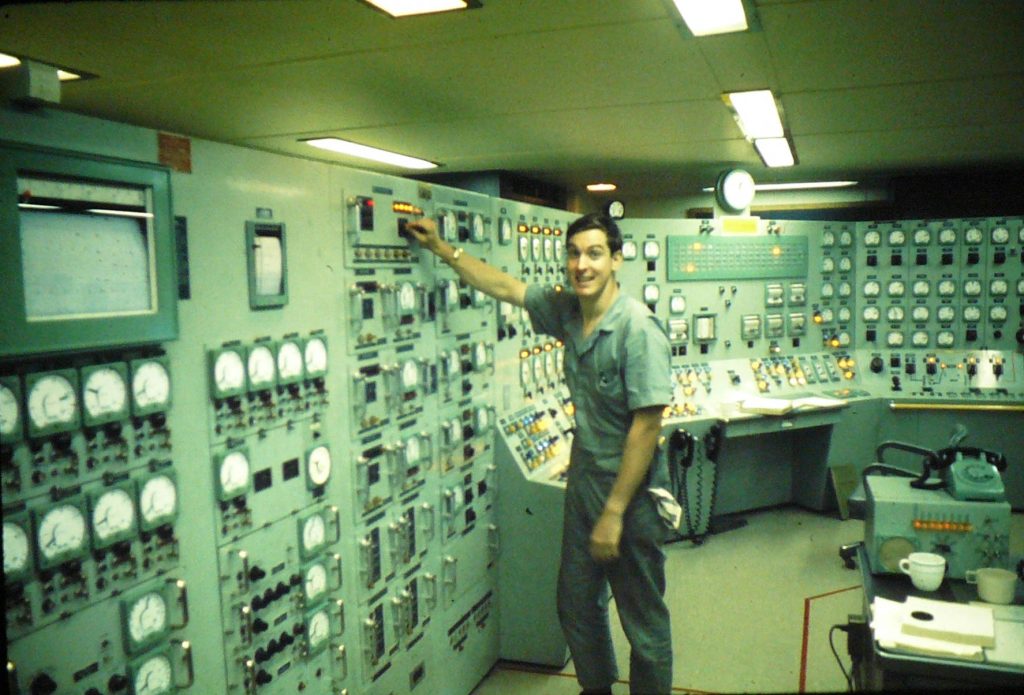Stuff about Sturgis

Oral history interviews are a great place to learn about parts of Panama Canal history that you might not have known about or have forgotten. At this year’s Panama Canal Society reunion in Orlando, we had the pleasure of meeting and talking to Carol Hellums.
She and her husband Bill had done an interview with the Panama Canal Museum in 2011 and it opens with a great story about how they met in 1968 on an airplane headed to Panama. Bill was moving down to serve as part of the crew on the Sturgis, and Carol was visiting her parents.
Carol taught us about the MH-1A pressurized water nuclear reactor, aka the Sturgis, the first floating nuclear power station. It was built by the Army Reactors Branch of the Army Corps of Engineers as a way to generate power in remote, inaccessible, or difficult locations – the “MH” stands for mobile, high power. The Sturgis was a converted Liberty Ship, a special class of cargo ship that was built during World War II. Because the vessel would be stationary for the majority of its life it was re-designed to be a towed craft, and it was taken to its home near the Gatun Spillway in August 1968.

In the early months of 1968, the Canal experienced a water shortage that affected both the operations of the Canal and the electricity supplied to the Canal Zone which was provided by the hydroelectric power station at Gatun Dam. By subsidizing the power station, the water that would have been used could instead be reserved for transiting ships.
The Sturgis generated electricity for the Canal Zone from 1968-1975, along with a second barge, the diesel-fueled Andrew J. Weber added in November 1968. It is estimated that they helped reserve over one trillion gallons of water for use in Canal operations.
Bill worked on the Sturgis monitoring the environment, taking water and sediment samples under the boat, and gathering biomass further afield in the jungles for radiological analysis. He and Carol joke that he basically got to fish in the Canal Zone for a living. Listen to a clip from their oral history below:
In the clip Bill mentions that The Big Picture, a news series produced by the U.S. Army, came down to Panama and filmed him. It took a while, but after watching a lot of episodes I finally found the one that features the Sturgis! View the episode below. The section about the Sturgis begins at 17:17:
Eventually two turbines were added to the Canal system and the Sturgis became obsolete. This story reminds us that the water shortage the Canal is experiencing today is not a new problem and that numerous efforts have been made to mitigate the issue over time. Creative solutions will undoubtedly continue be a part of the Canal’s future as it faces increasing environmental challenges.
In their interview, Bill also told an incredible story about a storm the Sturgis weathered during it’s trip back to Ft. Belvoir, Virginia to begin the deactivation of the reactor. Listen to a clip from the story:
Click through the slideshow below by pressing the arrows at the left and right sides of the image:
After the extensive process of deactivation, the ship was “mothballed” as part of the James River Reserve Fleet. Its final decontamination began in 2014 and by 2019 it had been scrapped.
To learn more about the origin, life, and decommissioning of the Sturgis view this U.S. Army Corps of Engineers exhibit: https://www.usace.army.mil/About/History/Exhibits/Nuclear-Power-Program/Sturgis/
To listen to Bill and Carol’s full interview visit out digital collection: An Interview with William and Carol Hellums
Do you remember seeing the Sturgis? Do you have any stories about the ship’s time at the Canal?
This post is part of our fall focus on the important work of the Panama Canal Museum and on the oral history program they began and which continues today. This year is the 25th anniversary of the founding of the Panama Canal Museum in 1998. The museum operated for 14 years in Seminole, Florida, before closing in July 2012 and transferring its collection to UF. The successes achieved by the museum paved the way for the PCMC to develop as a preeminent research collection for the study of the American era of the Canal. For more information on the history of the Museum, please visit go.ufl.edu/pcm
Between now and the end of December, we are celebrating their 25th Anniversary and hope to honor their hard work as well as that of our Friends of the PCMC group by adding $13,000 to the $12,000 that was raised by this year’s Silent Auction for a total of $25,000 – $25,000 for 25 amazing years!
If you would like help us reach the goal please donate here: https://pcmc.uflib.ufl.edu/oralhistory/. All funds will go to support the PCMC oral history program.



